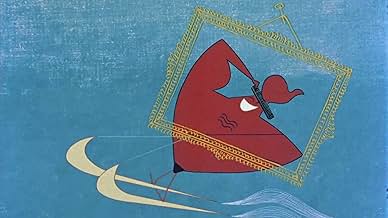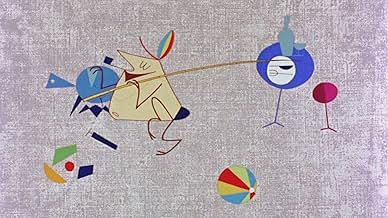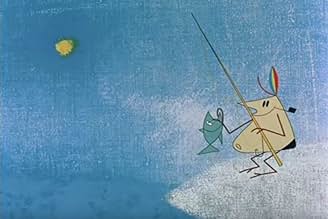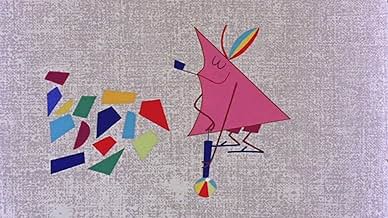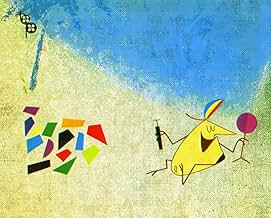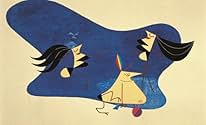Surogat
- 1961
- 10min
CALIFICACIÓN DE IMDb
7.2/10
1.4 k
TU CALIFICACIÓN
Agrega una trama en tu idiomaSimple story about the man who comes to the beach and uses inflatable objects for all of his needs.Simple story about the man who comes to the beach and uses inflatable objects for all of his needs.Simple story about the man who comes to the beach and uses inflatable objects for all of his needs.
- Dirección
- Guionista
- Ganó 1 premio Óscar
- 1 premio ganado en total
Opiniones destacadas
10llltdesq
Ersatz, an exceptional piece of work from Zagreb Films, was the first non-American work to win the Academy Award for Animated Short (though it was not the first for an independent studio-depending on definition, that honor would go to UPA or John Hubley's Storyboard, Inc) and deserved to win. It's lively, amusing, well-animated and stretches the envelope. Clearly influenced by UPA, as were most of the Eastern Europeans, I loved this the first time I saw this some 25 years ago, although I found it predictable in spots, including the ending. I saw it again recently and it still holds up. It's available on a tape produced by Rembrandt Films, called The Best of Zagreb Films: The Classic Collection, which may well be in print. Copies are certainly still floating around. Well worth tracking down. Most highly recommended
The main figure, who is mostly a triangle, has the ability to take geometric shapes and inflate them. He is quite hilarious as he dances through life. The figures become the things he needs to enjoy himself, be it water, vehicles, or anything else. He revels in his creations but we must know that he is, himself, a geometric shape. This is a really interesting idea, unlike anything I've seen before. By necessity, the drawings are not elaborate. But everything is as it should be.
10RobT-2
"Surogat" (mostly known in English-speaking countries as "Ersatz") was the first film produced outside the USA to win an Oscar for "best cartoon". While there were many great "foreign" cartoons in previous years, "Surogat"'s Oscar was auspicious in that it marked the point at which the mainstream of American animation took notice of such work. In view of the course American animation eventually took, it's easy to see why.
"Surogat" itself shows evidence of American influence, specifically from the UPA studios. UPA's animators developed a style (really a range of styles) taking cues from modern art and graphic design. Figures were rendered iconically; what they stood for was more important than their exact resemblance to what they depicted. UPA used this style to tell fables for a presumed adult audience, and avoided cuteness and slapstick.
"Surogat" is an adult fable as well, but obviously director Dusan Vukotic and writer Rudolf Sremec didn't feel bound by UPA's anti-slapstick rule. Otherwise, their film could easily pass as UPA product, though it outdoes all but UPA's very best work. The figures consist of simple geometric shapes, and most of their movements are either parallel to one of their edges or else curvilinear in the manner of "rubber-hose" animation; in other cases, they simply "pop" from one pose to another. (An acquaintance of mine called it "a bunch of triangles and shapes hopping around." "The Simpsons" effectively parodied the style by taking advantage of attitudes like that.) Despite this minimalism, the characters are identifiable as characters, and within the boundaries of fable the story works just fine.
UPA's main influence on American animation lay not in its "artistry" so much as the way its style was easy to copy, and to transfer over to "limited" animation for television, a growth industry at the time. TV animators also watched cartoons like "Surogat" for potential shortcuts they could use in their work. (I believe one immediately influential aspect of "Surogat" was its music, a sort of advanced semi-jazzy big-band/orchestral piece that wouldn't be out of place in, say, a "Jetsons" episode.)
However, when a new-generation of animators went to work for Hanna-Barbera and attempted to take their work "back to basics", they took artistic cues from UPA and other "artistic"/"iconic" work of the 1950's which influenced H-B. Hence, the influence of "Surogat" shows up in such recent work as "Two Stupid Dogs", "Dexter's Laboratory", "The Powerpuff Girls", and (the most self-consciously "artistic" of this group) "Samurai Jack".
Unfortunately, "Surogat"/"Ersatz" is very hard (at least for Americans) to find on video. Janus put it on a collection of short films, but this would appear to be out of print; however, it may be found in some libraries, especially those with older or larger video collections.
"Surogat" itself shows evidence of American influence, specifically from the UPA studios. UPA's animators developed a style (really a range of styles) taking cues from modern art and graphic design. Figures were rendered iconically; what they stood for was more important than their exact resemblance to what they depicted. UPA used this style to tell fables for a presumed adult audience, and avoided cuteness and slapstick.
"Surogat" is an adult fable as well, but obviously director Dusan Vukotic and writer Rudolf Sremec didn't feel bound by UPA's anti-slapstick rule. Otherwise, their film could easily pass as UPA product, though it outdoes all but UPA's very best work. The figures consist of simple geometric shapes, and most of their movements are either parallel to one of their edges or else curvilinear in the manner of "rubber-hose" animation; in other cases, they simply "pop" from one pose to another. (An acquaintance of mine called it "a bunch of triangles and shapes hopping around." "The Simpsons" effectively parodied the style by taking advantage of attitudes like that.) Despite this minimalism, the characters are identifiable as characters, and within the boundaries of fable the story works just fine.
UPA's main influence on American animation lay not in its "artistry" so much as the way its style was easy to copy, and to transfer over to "limited" animation for television, a growth industry at the time. TV animators also watched cartoons like "Surogat" for potential shortcuts they could use in their work. (I believe one immediately influential aspect of "Surogat" was its music, a sort of advanced semi-jazzy big-band/orchestral piece that wouldn't be out of place in, say, a "Jetsons" episode.)
However, when a new-generation of animators went to work for Hanna-Barbera and attempted to take their work "back to basics", they took artistic cues from UPA and other "artistic"/"iconic" work of the 1950's which influenced H-B. Hence, the influence of "Surogat" shows up in such recent work as "Two Stupid Dogs", "Dexter's Laboratory", "The Powerpuff Girls", and (the most self-consciously "artistic" of this group) "Samurai Jack".
Unfortunately, "Surogat"/"Ersatz" is very hard (at least for Americans) to find on video. Janus put it on a collection of short films, but this would appear to be out of print; however, it may be found in some libraries, especially those with older or larger video collections.
Regardless how good this cartoon is, I was amazed at how incredibly annoying the opening music was. Fortunately, the actual cartoon turned out to be much better, so don't give up just because the opening music is dreadful! As to the cartoon, you'll probably first notice its minimalist style. In many ways it looks like a Calder mobile and cartoon morphed into one. The odd lines and shapes are very artsy and very indicative of the 1960 "modern" look. To me, a lover of classic cartoons, the style looked just cheap and you could tell by the art work and cel count that it was not a high quality film.
Now despite these aesthetics, the film is actually pretty good--mostly due to a bizarre and very captivating story. An odd little man goes to the beach and begins pumping up little shapes until they become full-sized and apparently normal items--such as beach chairs, tents, etc.. Now here's where it gets weird....he also begins pumping shapes and they become ladies and the picture enters Weirdsville! However, you also find yourself laughing and looking forward to what's coming next.
A clever idea with less than terrific art work.
Now despite these aesthetics, the film is actually pretty good--mostly due to a bizarre and very captivating story. An odd little man goes to the beach and begins pumping up little shapes until they become full-sized and apparently normal items--such as beach chairs, tents, etc.. Now here's where it gets weird....he also begins pumping shapes and they become ladies and the picture enters Weirdsville! However, you also find yourself laughing and looking forward to what's coming next.
A clever idea with less than terrific art work.
A character arrives at the beach and thanks to his air pump, creates loads of useful inflatable things to make his day enjoyable. He has a tent, a table, chair and even a barbecue. He makes his own fish, then a fishing rod then after supper - complete with wine, he creates his own lady friend. She's not so keen on him though and when she runs off with an equally blown up lifeguard to a nearby island, he must pursue and thwart their ardour. You just know what's going to happen at the end, but even if the style of animation is a bit basic, the build up to that denouement is quite entertaining. Quirky, and worth ten minutes, I'd say.
¿Sabías que…?
- TriviaThe character design for the "Worker and Parasite" cartoon featured in Los Simpson (1989) episode Krusty Gets Kancelled (1993) was inspired by this film.
- ConexionesEdited into International Festival of Animation (1977)
Selecciones populares
Inicia sesión para calificar y agrega a la lista de videos para obtener recomendaciones personalizadas
Detalles
- Tiempo de ejecución
- 10min
- Mezcla de sonido
- Relación de aspecto
- 1.37 : 1
Contribuir a esta página
Sugiere una edición o agrega el contenido que falta

